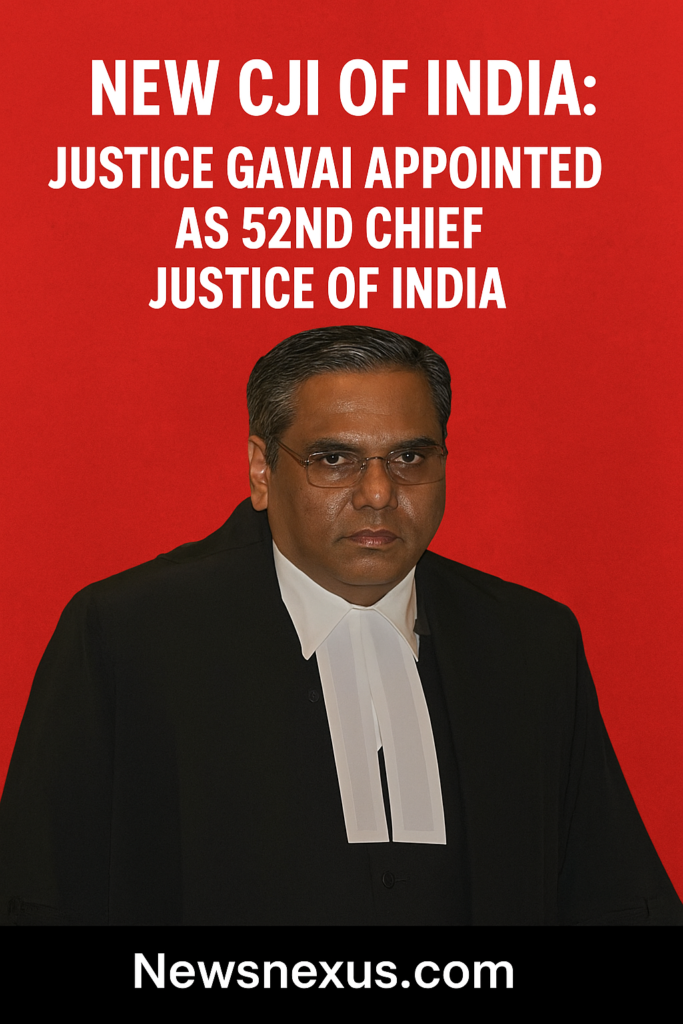
Historic Appointment for Justice Gavai
Justice D.Y. Chandrachud’s tenure as Chief Justice of India is nearing its end, and the legal fraternity is preparing for a significant transition. Justice Sanjiv Khanna has recommended the name of Justice B.R. Gavai as the next Chief Justice of India. The Ministry of Law and Justice has accepted this recommendation, making Justice Gavai the 52nd Chief Justice of India. His swearing-in ceremony is scheduled for May 14, and he will serve for a period of six months.
A Landmark Decision for Indian Judiciary
Justice Gavai’s elevation is not just a routine judicial appointment. It marks a historic moment, as he will be the second Chief Justice of India from a Scheduled Caste community after Justice K.G. Balakrishnan. His appointment sends a strong message about inclusivity in the Indian judiciary. It reflects the evolving structure of the Supreme Court, which now represents a broader section of Indian society.
Short Tenure, Big Opportunities
Though Justice Gavai will hold the office for only six months, his tenure is expected to be impactful. He brings vast experience in handling land acquisition and criminal law cases. These domains are often subject to widespread public interest and legal complexity. His brief tenure could still significantly influence ongoing debates and legal precedents.
Transparent Succession Process
Justice Gavai’s name was proposed through a transparent process. The current Chief Justice, Sanjiv Khanna, submitted the recommendation in accordance with established norms. This highlights the mature and stable process of succession in the Indian Supreme Court. It underscores a functioning system where merit and procedure align to maintain institutional integrity.
Legal Ministry’s Proactive Role
The Ministry of Law and Justice had asked Justice Khanna to recommend a successor. This reflects active cooperation between the judiciary and the executive. The prompt action by the law ministry shows the government’s seriousness in maintaining a seamless transition in judicial leadership. Such coordination helps maintain public trust and confidence in the legal system.
Key Cases Awaiting Justice Gavai’s Judgement
Justice Gavai’s tenure may coincide with critical judgments, including the long-pending Sabarimala review petition. This case, involving religious rights and gender equality, has divided public opinion. Justice Gavai’s experience and balanced approach could lead to a landmark ruling that shapes the social discourse of the country.
Strengthening Diversity in the Supreme Court
His appointment enhances diversity within the top court. India is a pluralistic society, and a diverse bench reflects its ethos. Justice Gavai’s presence can lead to more inclusive judicial thinking. It can help bridge the gap between marginalized communities and the judiciary. This is crucial for increasing acceptance of Supreme Court verdicts across all segments of society.
Judicial Impact Beyond Tenure
Even with a six-month term, Justice Gavai can initiate reforms and drive important decisions. Previous Chief Justices with short tenures have shown that duration does not limit impact. With focus and clarity, Justice Gavai can leave a legacy through landmark judgments and internal court reforms.
Public and Political Reactions
Legal experts and political commentators have welcomed the move. Many see it as a symbolic and strategic step to reinforce equality in judicial representation. Social media platforms like X (formerly Twitter) have buzzed with congratulatory messages and positive reactions. Public opinion leans towards hope and progress with Justice Gavai at the helm.
Conclusion: A New Chapter for Indian Judiciary
Justice Gavai’s appointment as the new CJI of India is more than just a change in leadership. It’s a statement about the future of India’s judicial system. With integrity, inclusivity, and experience, he is poised to uphold the dignity of the Supreme Court. His decisions in the coming months may shape the legal landscape and set the tone for the next era of justice in India.
